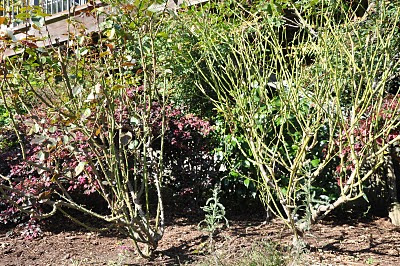


Get out your ladders! Most of the leaves are off the trees now. It makes for pretty collages on the ground, and also affords the opportunity to really look at the branching structure of the trees to which they belong. Also, these deciduous trees are dormant in the winter months, so we prune Japanese maples and other trees and shrubs that need careful shaping with major cuts now, before they leaf out and their sap starts to run. As a result, we often do our major pruning of fruit trees, Japanese maple and other deciduous tree, rose, and other woody winter perennials in January.

We work annually at this scenic garden in the El Cerrito hills overlooking Wildcat Canyon. The client has many mature, productive fruit trees, including several varieties of apples, plums, a fig, lemon, lime, loquat, nectarine, and pear. We have been pruning there for about five years and at the client's request have slowly been bringing down the height of all of them to a more harvestable height.

There are several great written pruning resources that we rely on. Most are available in the local nurseries in the winter season. This one is a great staple we love: How to Prune Fruit Trees, by R. Sanford Martin. (photo courtesy of Shae at Hitchhiking to Heaven), originally published in 1944. It has general instructions and diagrams on pruning almost every fruit tree we encounter around here on a regular basis.
Apples, pears, plums, cherries, and nectarines produce their flowers and then their fruit on special structures called fruiting spurs (seen below).

There are special pruning techniques that we use to encourage spur (and thus fruit) production. Without getting into too much detail, we generally cut off all dead and injured branches, and then cut back any whip-like vegetative growth and all crossing and inward-growing branches to encourage light penetration into the canopy. Then various pruning decisions are made based on type and age of the tree, height at which it is to be maintained, number of existing fruiting spurs (if there are many, then we cut some off to keep branches from breaking under the weight of heavy production, and to encourage regeneration when existing spurs are old) and whether or not it has been consistently pruned and shaped in past years. In this garden, the multi-talented Ami prunes and snacks on a Granny Smith Apple tree.

We prune the woody perennials at the same time. Some varieties of grasses get cut to the ground, and salvias, lavenders, rock roses, loropetalums, pittosporums among others, get a hard pruning and shaping. Shrubs that are blooming now, like some camellias, azaleas, rhododendrons, and choisya ternata are pruned later after bloom.
Roses: Before

After:

Then once all the space is cleared around the plants, we take the opportunity to put down organic fertilizer like this kind, or this kind, epson salts for the roses, chicken manure for the fruit trees, and then mulch all the beds, leaving them all tucked in and ready for spring!


 Fiddlehead Gardens
Fiddlehead Gardens  2816 8th St.
2816 8th St. 
wooow,that's amazing.such a beautiful scene of nature.You are doing great work for nature.Keep doing.Good luck!!
ReplyDeleteनेटफ्लिक्स हिंदी भारत में आती है, कंपनी नए उपयोगकर्ता इंटरफ़ेस जारी करती है-The TrendyFeed News.
Contact us for Guest Posting.
th eTrendyFeed News:
About The TrendyFeed is one of the new business news publications in India - 60% of readers did not read another business paper, making The TrendyFeed an important reach vehicle for top end audiences. The Trendyfeed among commercial letters in reference to readers.
For more information feel free to Contact Us
Email us to contact us: - thetrendyfeed@gmail.com or Contact@thetrendyfeed.com
This comment has been removed by the author.
ReplyDeleteThanks for sharing thhis
ReplyDelete